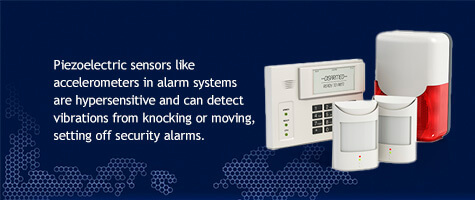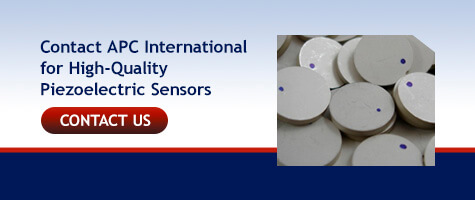Jump To: What Is It? | How It Works | Applications
Understanding the fascinating science behind piezoelectricity and piezoelectric sensors in various electrical and mechanical applications can help you determine the best business solutions and components.
Piezoelectric sensors are essential in various applications such as industrial, medical, aerospace engineering and military operations. Piezoelectric sensors also play a role in numerous everyday devices and applications, including smartphones, musical instruments, automotive sensing, and structural health monitoring in airplanes, buildings and bridges.
A piezoelectric sensor is a device that can convert various physical forces, including pressure, vibration and temperature, into electrical charges that can be measured. Piezoelectric sensors are in various electronic objects such as flow meters, sensors, ranging sensors and high-pitch buzzers.
Piezoelectric sensors come in multiple shapes depending on the structure they’re in. They’re made of either ceramic or crystal materials and are small, lightweight, hypersensitive and easy to mount into various appliances and equipment. Their properties make them popular devices for numerous industrial applications.
Piezoelectric sensors are present in several types of daily equipment. Piezoelectric devices can detect vibrations in alarm systems and alert you against intruders. They can help doctors measure pulses, and they can help industries such as automotive OEMs monitor motor bearings for wear and tear, predicting potential equipment failure. Piezoelectric sensors can even aid in energy harvesting.
Automotive and aerospace companies use piezoelectric sensors for non-contact applications because they’re robust enough to withstand harsh environments like high temperatures and engine pressures. Piezoelectric sensors convert physical parameters like pressure, strain, motion, temperature and vibration into an electrical charge that can be measured, processed and interpreted.
Piezoelectric sensors demand low power and are affordable. They are popular because of the following characteristics:
A piezoelectric sensor sends a signal when it sustains a physical force, which might be pressing, pushing, or changing temperature. Piezoelectric sensors generate an output signal directly from applied stress, requiring no external voltage.
The piezoelectric effect is the process that enables a signal output. This effect is how materials such as certain engineered ceramics, synthetics and select naturally-forming crystals generate an electric charge when they sustain mechanical stress like squeezing or pushing.
Here’s a brief example of how a piezoelectric pressure sensor works:
Voltage can also cause the piezoelectric material to change shape or make the crystal shrink or expand. This shape or size change is known as an inverse piezoelectric effect. The inverse piezoelectric effect can occur in many daily applications, creating and detecting high-pitch sounds and vibrations. It’s useful in siren applications such as smoke detectors and lower frequency applications such as sonar or underwater imaging.
A typical inverse piezoelectric effect application example is playing music on your smartphone or a doctor performing therapeutic ultrasound treatments. Piezoelectric crystals in speakers and ultrasonic equipment oscillate when alternating voltage is applied, creating sound waves or varying power levels and frequencies.
Piezoelectric sensors can also measure appliance vibrations for various reasons, like detecting wear in devices such as engines. Here are some common applications for piezoelectric sensors:


Piezoelectric sensors like accelerometers in alarm systems are hypersensitive and can detect vibrations from knocking or moving, setting off security alarms. The piezoelectric sensors in an alarm system detect mechanical vibrations, converting them into an electrical charge across the piezo crystal. The sensor sends a signal and triggers the alarm siren, also typically a piezo-driven device. You can place piezoelectric sensors on doors, windows, frames, or floors.
Certain smartphones contain piezoelectric touch sensors that are highly sensitive. The physical force of touching or typing on your phone screen triggers an electric charge across the piezoelectric sensor materials, indicating the proper command. Devices such as speakers, vibrators and camera-focusing equipment within certain smartphone devices also contain piezo materials.
Instruments like electric guitars, violins, pianos and even vocal microphones use piezoelectric sensors.
You can also use piezo sensors to amplify instruments like bass drums and cymbals. All sounds are vibrations, and directing these vibrations into a piezo sensor allows the sensor to process and amplify the sounds.
Electric guitars have a piezoelectric strip under the bridge that captures the vibration of the guitar strings, allowing the sensor to process and amplify the instrument’s produced sounds.
Piezoelectric sensors in pacemakers, stethoscopes and ultrasounds are hypersensitive and allow medical practitioners to monitor the heart rate and activity level of someone who has a pacemaker, measure a patient’s pulse while under anesthetic and hear a baby’s heartbeat with fetal heart monitoring. Ultrasonic medical equipment contains piezoelectric transducers, which create sound waves that can be transferred into the body when coupled to someone’s skin.
You can also use piezoelectric sensors in smartwatches. Piezoelectric sensors can detect and process vibrations from heartbeats and other movements to detect when people are active or inactive. This detection is useful for health monitoring because it helps doctors acquire useful data for patient health.
Individuals can store energy from wearable devices such as smartwatches, clothing and shoes for additional use. This practice is known as piezoelectric energy harvesting. Plenty of ongoing research surrounds piezoelectric energy harvesting and how much energy people can convert from vibrations from people walking, running and breathing.
Aerospace companies use piezoelectric pressure sensors in various applications, like measuring turbulence, engine combustion, and various dynamic pressures. High pressures and temperatures applied to piezoelectric materials generate an electrical charge that can be measured without moving parts. A piezoelectric pressure sensor’s reliability makes it popular for various aerospace applications.
Accelerometer sensors are a type of piezoelectric sensor. Various industries like automotive, security, military and industrial use piezo accelerometer sensors to measure vibrations, detect movements and monitor shock pulse in motor bearings. The military also uses piezoelectric accelerometers in various operations. Military personnel can use them to measure vibrations and explosion shocks, and aircraft and munition navigation systems can use them to measure movement, detect critical locations and collect performance data.


High-quality, affordable piezoelectric sensors are useful in numerous industrial applications. Since 1986, APC International has specialized in creating custom piezoelectric solutions, working with clients to determine and meet their exact needs. Contact APC International to learn more about piezoelectricity today.
APC International is Expanding
Piezo Buzzers vs. Magnetic Buzzers
Piezoelectric Effect vs. Piezoresistive Effect